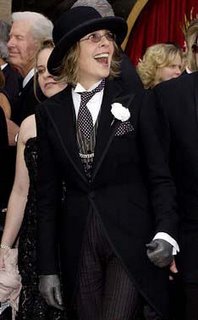Cross-dressing
I read Sandy Stone’s article and the posts about Michelle Obama and her clothing choices. After reading these, I have begun to wonder about transvestites or cross-dressers. I was a bit confused as to the differences between transsexuals and transvestites so I looked up the definitions. According to Wikipedia and Webster, cross-dressers are usually heterosexuals, homosexuals, bisexuals, or asexuals, who identify as male or female, but like to dress in the opposite gender’s clothing. We have not talked about this in class, so I wanted to bring it up. I am a little confused as to why they dress in clothing of the opposite gender. Do cross-dressers feel that there is something missing? They are in the “right” body, but perhaps, just enjoy fashion? I wish Stone had included more on transvestites in her article. Today, are styles still divided among genders? I feel that a woman could wear anything a man wears and not be labeled as a cross-dresser, but it seems that it is not the same for men. I realize that there are feminine ensembles, but are there male outfits? The first thing that I think of is a tux, but look at Diane Keaton. Has anyone called her a cross-dresser? But if a man wore a dress to an awards show, he would be labeled a cross-dresser (or everyone would think it was a joke).
In the Stone article she uses Lord Cornbury, as an example of a transsexual, but wasn’t he a cross-dresser? Stone states, “The first colonial governor of New York, Lord Cornbury, came from England fully attired as a woman and remained so during his time in office,” (323). Stone seems to be equating wearing the opposite gender’s clothing with the desire to be the opposite sex. This is contradictory to the definitions of transsexual and transvestite. Although I found the reading interesting, I also found a lot of problems with it. This was just one. I think Stone could have clarified her article more, creating a stronger argument. For example, when she discusses that “most transsexuals choose reassignment,” they are usually thirty or forty years old (334). She however, does not talk about the cost of this choice, or the technology that has come about in recent years. Perhaps, most of the individuals did not have enough money until they were in their thirties or forties. Also, how long have hormones, steroids, and reassignment surgery been around? I would really like to know, because aren’t we dealing with this issue today, because of the progress in technology?
Image: Google images
Comments are closed.

Hmm, very interesting. It’s important to remember that the technology used to create gender is not limited to surgery, and fashion is most certainly a technology we use to construct our identity.
As for cross-dressing, I don’t tend towards it for the most part (though exceptions exist and are well-documented), but I can definitely see the attraction. Girls have WAY more options for looking good than guys do, and I’ve gotten a little jealous on more than one occasion.
There is a BIG difference between transvestites and transsexuals. TVs want to wear clothes of the opposite sex. TSs want to BE the opposite sex, thinking they were born into the wrong body.
Solomon, you make a good point that fashion, as a technology, does structure the way we describe our genders. I think I may do some research into fashion as technology.
Keri, I realize the differences between the two. I just don’t think Stone made a distinction between transvestites and transsexuals. I am more confused about the reasons for cross-dressing. After reading about transsexuals, I feel like I have a better understanding, but I don’t for transvestites.
Aline et al,
Here’s one an explanation from an “executive transvestite:”
http://www.youtube.com/watch?v=qPML-n1kRnY&NR=1
Enjoy!
–R
Thanks Ryan! That was helpful.
“I am a little confused as to why they dress in clothing of the opposite gender. Do cross-dressers feel that there is something missing?”
I am also confused, but for a kind of opposite reason! Why do we have standards for how a man/woman “should” dress? When people are infants, I doubt they’re thinking “jeez, I really want to wear a skirt”. It doesn’t seem like something inborn to me. I know it probably gets back to historical reasons and our construction/”technology” (as Solomon put it) of gender.
I do think it’s interesting how it’s more accepted for women to dress “like men” as vice versa.
While we’re talking confusion, I’d be interested in hearing a little bit about how folks understand the difference between “butch” and “trans.” Is it a generational shift in terms, or are there distinctions in identity or presentation that make sense of the difference to you?
Not to avoid Anne’s question, but I wanted to respond to Natasha’s last sentence. I think it makes sense that it is more accepted (by …?) for women to dress like men than vice versa because of women’s push to gain similarity to men. I think that in the past (100?) years there has been a push from women to make society (US) accept women as equal to men – where equal seemed to often mean the same. For women to be able to have the jobs men have – for women to … say, wear the same clothes men wore etc. I don’t see as much as a push from women (or men) for men to (be able to) dress like women or have the jobs that women have or … I think that it is fascinating (disturbing) that women’s desire to ‘be equal to’ men often translated into women acting more like men, not men acting like women, not both acting like something else, not ….